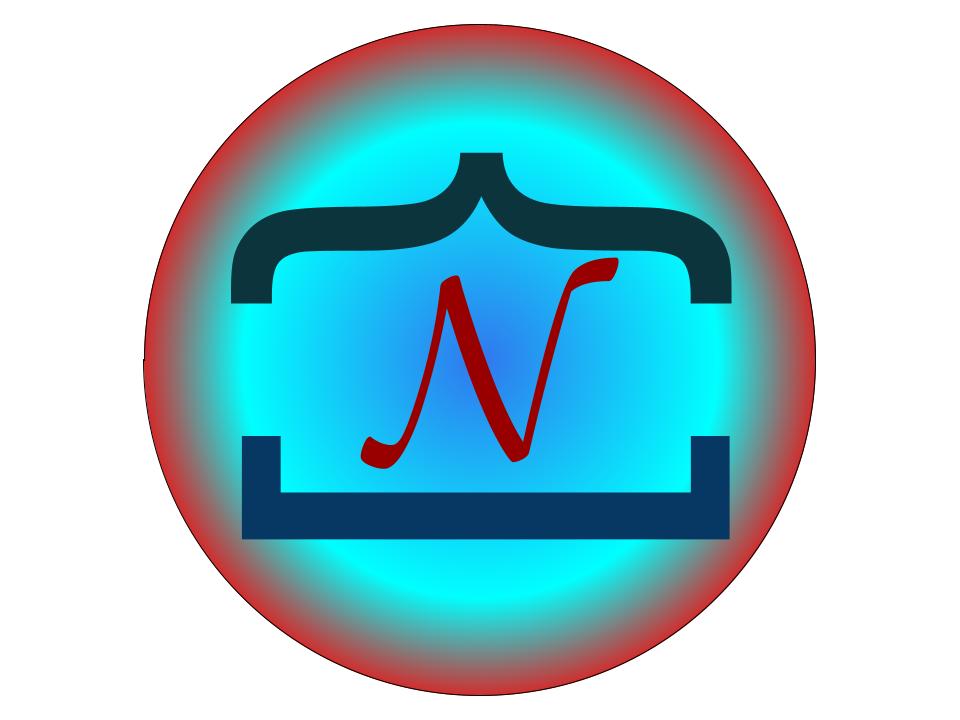Eigen values#
Author: Nipun Batra, Zeel B Patel
In this notebook, we will look at eigen values. https://youtu.be/PFDu9oVAE-g
import numpy as np
import matplotlib.pyplot as plt
from matplotlib import rc
from matplotlib.animation import FuncAnimation
rc('font', size=16)
rc('text', usetex=True)
rc('animation', html='jshtml')
Consider a vector \(\mathbf{v}_1\) below,
v1 = np.array([2, 1])
plt.arrow(x=0, y=0, dx=v1[0], dy=v1[1], shape='full', head_width=0.2, head_length=0.2, length_includes_head=True)
plt.text(0-0.2, 0+0.2, f'({0}, {0})')
plt.text(v1[0]-0.2, v1[1]+0.2, f'({v1[0]}, {v1[1]})')
plt.scatter(0, 0)
plt.grid()
plt.ylim((-1, 3))
plt.xlim(-1, 3);
plt.xlabel('x');plt.ylabel('y');
plt.title('$\mathbf{v}_1 = [2\;\;\;1]$');
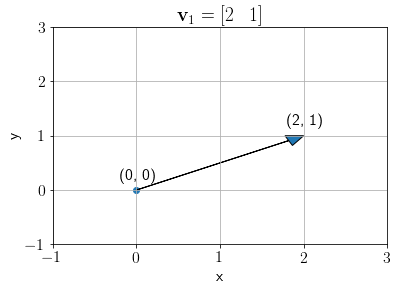
\(\mathbf{v}_1\) gets transformed to \(\mathbf{v}_1'\) after applying a transformation \(A\).
We define a useful function for plotting a linear transformation on any vector.
def plot_transformation(x, A, ax, annotate=False):
arrow_in = ax.arrow(x=0, y=0, dx=x[0, 0], dy=x[1, 0], shape='full', head_width=0.4,
head_length=0.4, color='green', lw=8, alpha=0.6, length_includes_head=True)
ax.grid()
# Applying transformation
Ax = A@x
# Get current min, max
ymin, ymax = (min(Ax[1], x[1], 0)-1, max(Ax[1], x[1], 0)+1)
xmin, xmax = (min(Ax[0], x[0], 0)-1, max(Ax[0], x[0], 0)+1)
# Check and update according to previous
ax.set_ylim(min(ymin, ax.set_ylim()[0]), max(ymax, ax.set_ylim()[1]))
ax.set_xlim(min(xmin, ax.set_xlim()[0]), max(xmax, ax.set_xlim()[1]))
arrow_out = ax.arrow(x=0, y=0, dx=Ax[0, 0], dy=Ax[1, 0], shape='full', head_width=0.4,
head_length=0.4, color='red', length_includes_head=True)
if annotate:
ax.text(0-1, 0+0.2, f'({0}, {0})')
ax.text(x[0, 0]-1, x[1, 0]+0.2, f'v1=({x[0, 0]}, {x[1, 0]})')
ax.text(Ax[0, 0]-1, Ax[1, 0]+0.2, f'v1\'=({Ax[0, 0]}, {Ax[1, 0]})')
ax.legend([arrow_in, arrow_out, ], ['Input','Transformed',], loc='lower right')
ax.set_aspect('equal')
ax.set_xlabel('x');ax.set_ylabel('y')
We plot the following transformation.
fig, ax = plt.subplots()
plot_transformation(np.array([2, 1]).reshape(-1, 1), np.array([[3, 1], [0, 2]]), ax, annotate=True);
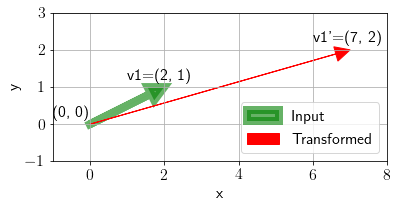
Now, we define a function to subtract a scaler \(\lambda\) from diagonal of \(A\).
def A_minus_lmd(A, lmd):
A[0, 0] = A[0, 0] - lmd
A[1, 1] = A[1, 1] - lmd
return A
Transforming a random vector with \(A-\boldsymbol{\lambda} I\) matrix.
fig, ax = plt.subplots()
plot_transformation(np.array([-2, 1]).reshape(-1,1), A_minus_lmd(np.array([[3, 1], [0, 2]]), 2), ax, annotate=True);

Let us visualize many such random vectors after transforming with \(A - \boldsymbol{\lambda} I\) (taking \(\boldsymbol{\lambda} = 2\)).
lmd = 2
fig, ax = plt.subplots()
def update(x):
i, j = x
ax.cla()
plot_transformation(np.array([-i, j]).reshape(-1,1), A_minus_lmd(np.array([[3, 1], [0, 2]]), lmd), ax)
ax.set_xlim(-11,11)
ax.set_ylim(-11,11)
frames = []
for i in range(-5, 5, 1):
for j in range(-5, 5, 1):
frames.append((i, j))
plt.tight_layout()
anim = FuncAnimation(fig, update, frames)
plt.close()
anim
Now we visualize these random vectors after transforming with \(A - \boldsymbol{\lambda} I\) (taking \(\boldsymbol{\lambda} = 3\)).
lmd = 3
fig, ax = plt.subplots()
def update(x):
i, j = x
ax.cla()
plot_transformation(np.array([-i, j]).reshape(-1,1), A_minus_lmd(np.array([[3, 1], [0, 2]]), lmd), ax)
ax.set_xlim(-11,11)
ax.set_ylim(-11,11)
frames = []
for i in range(-5, 5, 1):
for j in range(-5, 5, 1):
frames.append((i, j))
plt.tight_layout()
anim = FuncAnimation(fig, update, frames)
plt.close()
anim
For these two values of lambda (eigen values), any input vector will be squished to the two red lines shown. As per definition of eigen values, \(|A-\boldsymbol{\lambda} I|=0\), so new tranformation matrix becomes rank \(1\).
Let us see the same phenomena mathematically.
For \(\boldsymbol{\lambda} = 2\), we have
So, every transformation is lying on \(y'=0\) line.
For \(\boldsymbol{\lambda} = 3\), we have
So, every transformation is lying on \(y'=-x'\) line.
Let us take an input vector \([1\;\;\;-1]^T\) and visualize it’s transformation with \(A\).
fig, ax = plt.subplots()
plot_transformation(np.array([1, -1]).reshape(-1,1), np.array([[3, 1], [0, 2]]), ax, annotate=True);
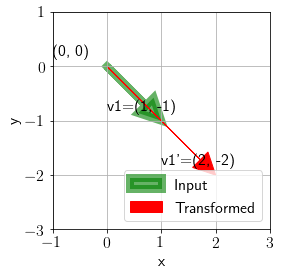
Note that this special vector is not changing direction but only the magnitude. All such special vectors under transformation \(A\) are eigen vectors of \(A\).
We can see that the transformed vector is \(2\) times longer. This denotes that for eigen vector \(\mathbf{e} = [1\;\;\;-1]^T\) corresponding eigen value is \(2\).
Now, let us check for input vector \([1\;\;\;0]^T\),
fig, ax = plt.subplots()
plot_transformation(np.array([1, 0]).reshape(-1,1), np.array([[3, 1], [0, 2]]), ax, annotate=True);
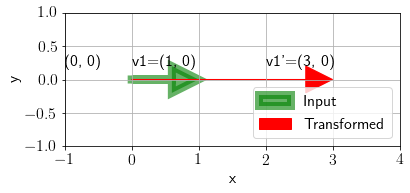
We can see that the transformed vector is \(3\) times longer. This denotes that for eigen vector \(\mathbf{e} = [1\;\;\;0]^T\) corresponding eigen value is \(3\).
